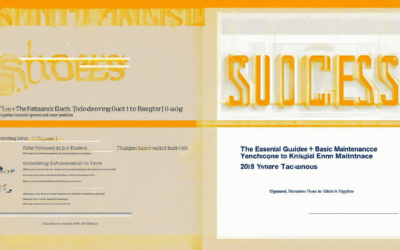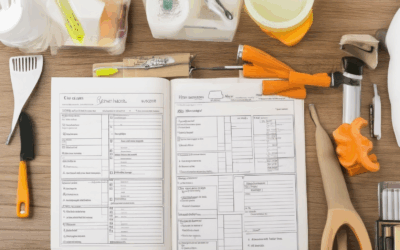In today’s fast-paced world, DIY culture has surged, empowering individuals to take charge of their living spaces. For many, this extends to home upkeep—a realm where simple fixes and routine checks can prevent costly repairs and enhance longevity. Whether you’re a seasoned homeowner or new to the game, mastering DIY home upkeep ideas can be both rewarding and cost-effective. This guide delves into the most common DIY home repairs, essential tools for simple projects, and strategies to maintain your property in top shape. From the 1% rule for home maintenance to budget-friendly tips, we cover everything you need to know to keep your home in pristine condition. Discover how to build a low-maintenance house, identify often-overlooked tasks, and stay ahead of potential issues before they arise. With the right approach, DIY home upkeep becomes a manageable and enjoyable part of homeownership.

Most Common DIY Home Repairs
Fixing squeaky doors and windows, patching drywall, unclogging toilets, and painting interior walls are among the most common DIY home repairs that homeowners often undertake. However, there are several other essential tasks that are frequently tackled by DIY enthusiasts. Below is a list of the most common DIY home repairs, along with practical tips and insights:
- Fixing Leaky Pipes : Identifying and addressing leaks in plumbing systems is a frequent DIY task. Locate the source of the leak, turn off the water supply, and replace worn-out washers or pipes as needed.
- Replacing Light Switches : Upgrading or replacing outdated light switches is a common repair. Simply turn off the power, remove the old switch, and install a new one according to the manufacturer’s instructions.
- Installing Ceiling Fans : Adding ceiling fans to a room can improve airflow and comfort. Measure the area, attach the fan to the ceiling, and secure it properly using the mounting hardware provided.
- Repairing Furniture : Small damages like scratches or loose handles can often be fixed with basic tools. Sand the affected area, apply a matching finish, and tighten any loose components.
These repairs not only save money but also empower homeowners to maintain their properties effectively. Whether it’s a minor fix or a more substantial project, DIY repairs can enhance both functionality and aesthetics. Always prioritize safety and consult reliable resources or professionals when unsure about complex tasks.
What is the 1% Rule for Home Maintenance?
The 1% rule for home maintenance is a simple yet effective strategy to ensure your property stays in great shape. Here’s how it works:
1. **Calculate Your Annual Maintenance Budget**: Start by determining 1% of your home’s purchase price. This percentage should be set aside annually for routine maintenance tasks.
2. **Examples of Home Maintenance Needs**: – **HVAC Systems**: Regular check-ups, filter changes, and tune-ups. – **Plumbing**: Leaky pipes, water heater inspections, and replacements. – **Roofing**: Annual inspections and minor repairs. – **Landscaping**: Lawn care, tree trimming, and gutter cleaning. – **Appliances**: Refrigerator, washer, dryer, and dishwasher maintenance or replacement.
3. **Why the 1% Rule Matters**: – Prevents small issues from becoming big problems. – Ensures your home remains safe and functional. – Saves money by addressing issues before they escalate.
By following the 1% rule, you’re taking a proactive approach to maintaining your home. This small investment in care ensures your property stays in excellent condition for years to come.
For more tips and resources on home maintenance, visit our website . Looking for additional guidance? Check out these trusted partners: Home Advisors and Fixer Upper .

Regular Home Maintenance Checklist
- Plumbing:
- Check for leaks under sinks and around pipes.
- Run water through each drain to ensure smooth flow.
- Use a plunger or drain cleaner for minor clogs (avoid chemicals).
- Electrical Systems:
- Test all switches and outlets for functionality.
- Inspect for tripping hazards like loose wires or chords.
- Heating & Cooling Systems:
- Clean or replace air filters monthly.
- Inspect vents and ductwork for obstructions.
- Schedule professional inspection annually.
- Exterior Maintenance:
- Check roof for missing shingles or damage.
- Clean and inspect gutters and downspouts.
- Examine chimney for cracks or blockages.
- Look for peeling paint or rotten wood on exterior surfaces.
- Appliance Care:
- Change HVAC filters quarterly and clean ductwork.
- Clean vent hood filters and exhaust fan grilles.
- Inspect washer and dryer hoses for damage.
- Run dryer with door open to prevent mold growth.
- Fire Safety:
- Test smoke detectors and replace batteries monthly.
- Check fire extinguishers for charge and expiration dates.
- Map out fire escape routes and practice annually.
- Flooring & Surfaces:
- Regularly clean and mop floors.
- Inspect tiles for looseness or damage.
- Seal grout and check underneath furniture for sagging floors.
- Windows & Doors:
- Ensure proper closure and locking mechanisms function.
- Check insulation for gaps and apply weatherstripping as needed.
- Clean window screens and tracks.
- Garden & Yard:
- Prune trees and shrubs to maintain health and safety.
- Implement weed control measures.
- Inspect water features for leaks or blockages.
- Clean gutters thoroughly.
- Personal Safety:
- Identify and remove tripping hazards like loose rugs or uneven surfaces.
- Check staircases for wobbliness or missing steps.
- Secure handrails and inspect for exposed wires or frayed cords.
- Security Systems:
- Test locks and ensure all entry points are secure.
- Check alarm systems for functionality.
- Consider adding security cameras if needed.
- Water Heater Maintenance:
- Check pressure relief valve function.
- Drain water heater tank periodically.
- Adjust temperature settings for efficiency.
- Professional servicing recommended for older models.
- Regular Inspections:
- Scheduled inspections for chimneys, septic tanks, and HVAC systems.
- Keep maintenance records for tracking and compliance.
- Garage Door & Organization:
- Check garage door balance and operation.
- Organize tools and supplies for easy access.

Most Overlooked Home Maintenance Tasks
Home maintenance is crucial for preserving the value and comfort of your living space. While some tasks are commonly addressed, others often get neglected, leading to bigger issues down the line. Here are some essential yet frequently overlooked home maintenance tasks:
- Gutter Cleaning and Repair: Clogged gutters can lead to water damage and foundation issues. Regularly clean out debris and inspect for cracks or loose hinges.
- Chimney Inspection: Creosote buildup and damaged flues can pose fire hazards. Have your chimney inspected and cleaned annually.
- Attic Insulation Check: Proper insulation prevents energy loss and moisture damage. Ensure your attic is well-insulated and free of leaks.
- Flooring Maintenance: Clean and inspect hardwood floors regularly to prevent dust and grime buildup. Address any warping or uneven spots promptly.
- Appliance Safety Checks: Test smoke detectors, carbon monoxide alarms, and ensure appliances like refrigerators and ovens are functioning properly.
- Drain Cleaning: Slow drains can signal clogs. Use a drain cleaner or snake to remove blockages and prevent backups.
- Grout and Tile Maintenance: Clean grout lines and check for cracks or discoloration. Sealing grout can protect against stains and moisture.
- Exterior Paint Touch-ups: Peeling or faded paint on siding, trim, or decks can detract from your home’s curb appeal. Schedule regular touch-ups to maintain a fresh look.
- Foundation Crack Repairs: Cracks in the foundation can allow water to enter, causing structural issues. Seal cracks and consult a professional if needed.
- Regular HVAC Service: Clean or replace air filters monthly and schedule annual tune-ups to ensure your heating and cooling systems run efficiently.
By addressing these often-overlooked tasks, you can save yourself from costly repairs and extend the life of your home. Prioritize these maintenance activities to keep your property in great shape year-round.
How to Build a Low-Maintenance House
To construct a low-maintenance house, focus on selecting durable materials and efficient systems that minimize ongoing upkeep. Here’s a step-by-step guide:
- Choose Durable Materials:** – Opt for materials like stone, concrete, or vinyl siding for exterior walls, as they resist wear, fading, and insect damage. Learn more .
- Install a Metal Roof:** – Metal roofs are long-lasting and require less maintenance compared to asphalt shingles. They effectively shed water and withstand harsh weather conditions. Find out more .
- Select Energy-Efficient Windows:** – Use high-quality windows with low-E glass to reduce heat loss and gain, making your home more energy-efficient. Clean them less frequently due to their ease of maintenance. See options .
- Implement Smart Home Systems:** – Install programmable thermostats, automated lighting, and security systems to enhance convenience and reduce energy waste. These systems often come with remote controls for easy adjustments. Discover solutions .
- Design Low-Maintenance Landscaping:** – Use native plants suited to your region’s climate to minimize watering needs. Incorporate hardscaping elements like patios and retaining walls made from durable materials. Get tips .
- Use Easy-Clean Interior Finishes:** – Choose flooring options like tile, linoleum, or vinyl, which are simple to maintain. Opt for low-maintenance appliances and fixtures to streamline cleaning efforts. View options .
- Conduct Regular Inspections:** – Schedule annual checks for critical areas such as the roof, gutters, and plumbing to identify and fix potential issues before they escalate. Book services .
- Consider Water Management Features:** – Install rainwater harvesting systems to supplement irrigation and reduce water usage. Ensure proper drainage to prevent flooding and water damage. Explore techniques .
- Future-Proof with Sustainable Technologies:** – Invest in solar panels and battery storage systems to reduce reliance on traditional energy sources and lower long-term maintenance requirements. Find solutions .

What Are the Most Common Preventative Maintenance Tasks?
Preventative maintenance is a critical aspect of ensuring the longevity and efficiency of your equipment, appliances, and systems. Regularly performing these tasks helps catch potential issues before they escalate, saving time, money, and effort in the long run. Below are some of the most common preventative maintenance tasks:
- Oil and Filter Changes : Regularly changing the oil and oil filters in your car, truck, or machinery is essential to prevent sludge buildup and maintain engine health. Dirty oil can lead to mechanical failure and decreased performance.
- Lubrication : Applying the correct type and amount of lubricant to moving parts can reduce friction and wear, extending the life of your tools and machinery.
- Filter Replacement : Cleaning or replacing air filters, furnace filters, and other filters regularly ensures proper airflow and prevents blockages, which can strain your equipment.
- Inspections : Conducting regular visual inspections of your property, vehicles, and major appliances can help identify small issues before they become big problems. Look for signs of wear, rust, or damage.
- Adjustments : Tuning or adjusting components like belts, chains, and valves ensures optimal performance and minimizes the risk of malfunctions.
- Belts and Hoses : Checking and replacing worn-out belts and hoses in your engines and machinery is vital to prevent costly breakdowns. Hoses can crack or fray, leading to fluid leaks.
- Thermometer and Pressure Gauge Checks : Ensuring your heating and cooling systems have properly functioning thermometers and pressure gauges allows you to monitor performance and adjust settings as needed.
- Electrical Systems : Inspecting circuits, switches, and wiring regularly can prevent electrical fires and ensure safe operation of your appliances and lighting fixtures.
- Plumbing Checkups : Examining pipes, faucets, and water heaters for leaks or corrosion helps maintain water flow and prevent costly plumbing issues.
- Documenting Maintenance : Keeping a record of all maintenance activities, including dates and descriptions, can be invaluable for future repairs and for tax purposes.
Scheduling regular preventative maintenance tasks ensures your equipment runs smoothly and extends its lifespan. For more detailed guidance on specific systems, visit our Home Maintenance Tips and Appliance Maintenance Guides pages.
Conclusion
By prioritizing preventative maintenance, you take a proactive approach to preserving your investments and ensuring reliable performance. Regularly addressing these tasks not only saves time but also enhances safety and efficiency. Remember to stay vigilant and address any issues promptly to maintain the peak condition of your belongings.




0 Comments